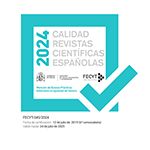Necrópolis rupestres y el poblamiento altomedieval en el Alto Arlanza (Burgos)
Resumen
El estudio del poblamiento altomedieval en el Alto Arlanza sigue vinculado, casi en exclusiva, al análisis que deriva de una visión difusa de sus necrópolis rupestres. Los problemas de visibilidad que plantean los testimonios materiales de estos asentamientos han provocado, como ha ocurrido en otros territorios, que el análisis arqueológico tradicional se haya focalizado en el estudio exclusivo de los elementos funerarios, por lo que disponemos en realidad de un registro parcial y claramente deficitario de las evidencias aldeanas. Poner de relieve la notable indefinición de estos testimonios y señalar las dificultades cronológicas que afecta a estas evidencias constituye dos elementos de reflexión necesarios para redefinir las nuevas estrategias en la construcción de un registro de calidad que permita adentrarnos con seguridad en la génesis del paisaje medieval y, en particular, en la formación de la red aldeana.Descargas
Descarga artículo
Licencia
La revista En la España Medieval, para fomentar el intercambio global del conocimiento, facilita el acceso sin restricciones a sus contenidos desde el momento de su publicación en la presente edición electrónica, y por eso es una revista de acceso abierto. Los originales publicados en esta revista son propiedad de la Universidad Complutense de Madrid y es obligatorio citar su procedencia en cualquier reproducción total o parcial. Todos los contenidos se distribuyen bajo una licencia de uso y distribución Creative Commons Reconocimiento 4.0 (CC BY 4.0). Esta circunstancia ha de hacerse constar expresamente de esta forma cuando sea necesario. Puede consultar la versión informativa y el texto legal de la licencia.
La revista En la España Medieval no cobra por tasas por envío de trabajos, ni tampoco cuotas por la publicación de sus artículos.












